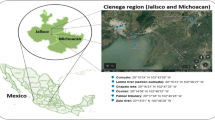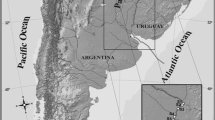Abstract
The South Florida Water Management District is a state agency that manages surface and ground water quantity and quality in south Florida. Since 1984 surface water and sediment have been sampled for pesticides at various frequencies and locations in the District's 1400-mile system of canals. Based on monitoring data from 1992 to 2001 the most common pesticides detected in surface water samples were herbicide compounds, especially ametryn and atrazine, while DDE and DDD were the most frequently detected in sediment samples. Exceedances of state surface water quality standards occurred in certain basins for several insecticides including endosulfan. In addition, the concentrations of several ubiquitous organochlorine compounds in sediment were similar to or exceeded threshold effect levels based on a comparison to the NOAA screening quick reference tables (or SQuiRTs) for sediment.
Similar content being viewed by others
References
Carriger, J.F., Rand, G.M., Chen, L., Williams, E.B., Quesada-Embid, M., Chen, L.M., Mahabir, S. and Coronel, L. (2002). Probabilistic Aquatic Risk Assessment of Pesticides in the C-111 Canal System, South Florida. Presentation (Absract P-383) at SETAC 23rd Annual Meeting, November 2002, Salt Lake City, UT.
Johnson, W.W. and Finley, M.T. (1980). Handbook of Acute Toxicity of Chemicals to Fish and Aquatic Invertebrates. U.S. Department of the Interior, Fish and Wildlife Service Resource Publication 137, Washington, DC.
Mayer, F. Jr. and Ellersieck, M.R. (1986). Manual of Acute Toxicity: Interpretation and Database for 410 Chemicals and 66 Species of Freshwater Animals. U.S. Department of the Interior, Fish and Wildlife Resource Publication 160.
Miles, C.J. and Pfeuffer, R.J. (1994). Pesticide Residue Monitoring in Sediment and Surface Water Within the South Florida Water Management District: Vol. 3. Draft Technical Publication. South Florida Water Management District. West Palm Beach, FL.
Miles, C.J. and Pfeuffer, R.J. (1997). Pesticides in canals of south Florida. Arch.Environ.Contam.Toxicol. 32, 337–45.
Montgomery, J.H. (1993). Agrochemicals Desk Reference: Environmental Data. Boca Raton, FL: Lewis Publishers.
National Research Council Canada (1975). Endosulfan: Its Effects on Environmental Quality. NRCC No. 14098. Ottawa, Canada.
Pait, A.S., De Souza, A.E. and Farrow, D.R.G. (1992). Agricultural pesticide in coastal areas: a national summary. Report for Strategic Environmental Assessment Division, Office of Ocean Resources Conservation and Assessment, National Ocean Service, NOAA: Rockville, MD. 81 pp.
SETAC (1994). Aquatic Dialogue Group: Pesticide Risk Assessment and Mitigation. Society of Environmental Toxicology and Chemistry (SETAC). Pensacola, FL: SETAC Foundation for Environmental Education. 220 pp.
Solomon, K.R. (1996). Overview of recent developments in ecotoxicological risk assessment. Risk Analysis 16, 627–33.
Suter, G.W. III. (1993). Ecological Risk Assessment. Boca Raton, FL: Lewis Publishers.
Traas, T.P., van de Meent, D., Posthuma, L., Hamers, T., Kater, B.J., de Zwart, D. and Aldenberg, T. (2002). The potentially affected fraction as a measure of ecological risk. In L. Posthuma, G.W. Suter and T.P. Traas (eds). Species Sensitivity Distributions in Ecotoxicology. pp. 315–44. Boca Raton, FL: Lewis Publishers.
U.S. Environmental Protection Agency (1990). National Pesticide Survey: Phase I Report. PB91–125765. National Technical Information Service. Springfield, VA.
Author information
Authors and Affiliations
Rights and permissions
About this article
Cite this article
Pfeuffer, R.J., Rand, G.M. South Florida Ambient Pesticide Monitoring Program. Ecotoxicology 13, 195–205 (2004). https://doi.org/10.1023/B:ECTX.0000023565.91904.20
Issue Date:
DOI: https://doi.org/10.1023/B:ECTX.0000023565.91904.20




